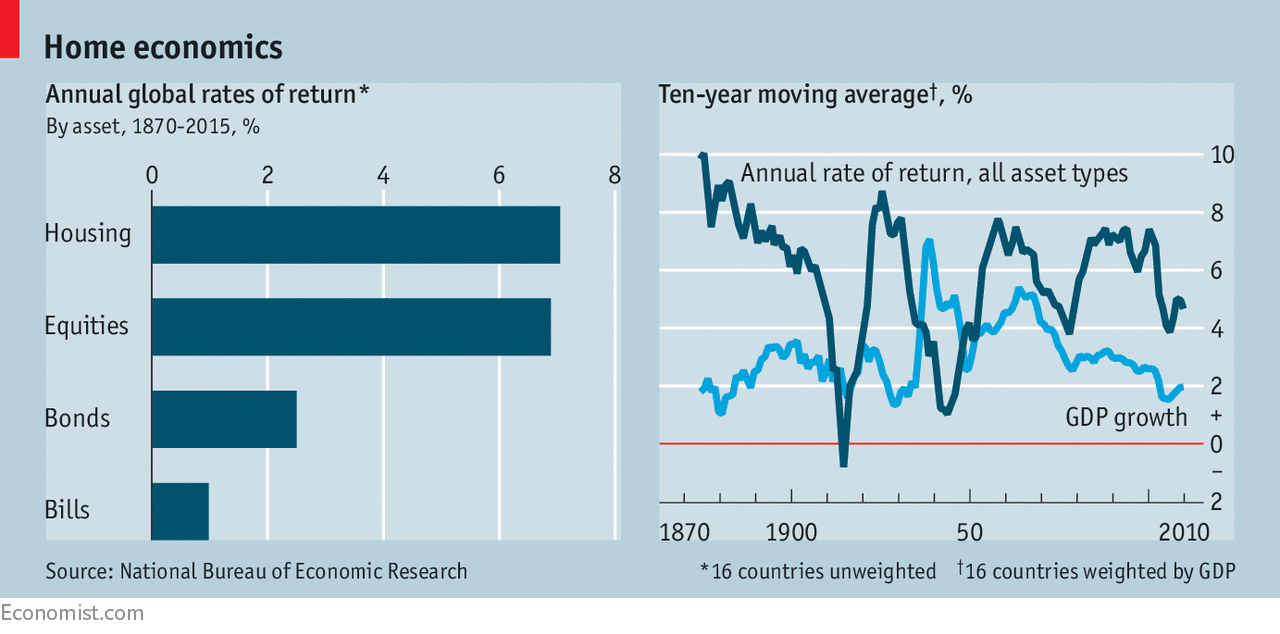Many happy returns: new data reveal long-term investment trends

DATA-GATHERING is the least sexy part of economics, which is saying something. Yet it is also among the most important. The discipline is rife with elaborate theories built on assumptions that turned out to be false once someone took the time to pull together the relevant data. Accordingly, one of the most valuable papers produced in 2017 is an epic example of data-retrieval: a piece of research that spells out the rates of return on important asset classes, for 16 advanced economies, from 1870 to 2015. It is fascinating work, a rich seam for other economists to mine, and a source of insight into some of today’s great economic debates.
Rates of return both influence and are influenced by the way firms and households expect the future to unfold. They therefore find their way into all sorts of economic models. Yet data on asset returns are incomplete. The new research, published as an NBER working paper in December 2017, fills in quite a few gaps. It is the work of five economists: Òscar Jordà of the San Francisco Fed, Katharina Knoll of the Bundesbank, Alan Taylor of the University of California, Davis, and Dmitry Kuvshinov and Moritz Schularick, both of the University of Bonn. (Messrs Jordà, Schularick and Taylor have spent years building a massive collection of historical macroeconomic and financial data.) For each of the 16 economies, they craft long-term series showing annual real rates of return—taking into account both investment income, such as dividends, and capital gains, all net of inflation—for government bonds and short-term bills, equities and housing. Theirs is the first such data set to gather all of that information for so many countries over so long a period.
As such, the authors establish some new basic economic facts. They conclude, for instance, that over the very long run it is housing, rather than equities, which provides the best return (see chart): both asset types have yielded about 7% a year on average over the 145 years, but equity returns are much more volatile. It is important to note that, though homeowners might cheer this news, it is not necessarily a reason to leap into the housing market. Rental yields account for about half of the long-run return on housing, and owning a diversified portfolio of rent-yielding property is not the same bet as borrowing to house the family.
The new old normal
Besides offering these baseline findings, the authors’ work helps to answer several pressing economic questions. One example is the puzzle of declining interest rates. The falling rates of the past few decades distress some economists, who worry they betoken weak growth and complicate central bankers’ ability to manage the economy. Yet the long-run data reveal that the high rates of return on government debt seen in the 1980s were an anomaly. The real return on bonds and short-term bills is normally relatively low—and can even be negative for long periods of time—as some other economists (such as Carmen Reinhart of Harvard University and Belen Sbrancia of the IMF) have also found. Recent declines therefore represent a return to more typical conditions.
That, in turn, suggests that central bankers who hope to “normalise” interest rates may be in for a rude surprise. But low rates of return also mean that government-debt burdens may prove easier to manage than thought—and perhaps that government borrowing could be used more aggressively in times of economic weakness to make up for central-bank impotence. Nor do low rates of return on government debt imply that the world is entering a period of “secular stagnation”, or chronically weak growth. Low rates have in the past been as much a feature of rip-roaring economies—eg, in the 1950s and 1960s—as of the more stagnant ones experienced recently.
More bracing still are the data’s implications for debates on inequality. Karl Marx once reasoned that as capitalists piled up wealth, their investments would suffer diminishing returns and the pay-off from them would drop towards zero, eventually provoking destructive fights between industrial countries. That seems not to be true; returns on housing and equities remain high even though the stock of assets as a share of GDP has doubled since 1970. Gravity-defying returns might reflect new and productive uses for capital: firms deploying machines instead of people, for instance, or well-capitalised companies with relatively small numbers of employees taking over growing swathes of the economy. High returns on equity capital may therefore be linked to a more tenuous status for workers and to a drop in the share of GDP which is paid out as labour income.
Similarly, long-run returns provide support for the grand theory of inequality set out in 2013 by Thomas Piketty, a French economist, who suggested (based in part on his own data-gathering) that the rate of return on capital was typically higher than the growth rate of the economy. As a consequence, the stock of wealth should grow over time relative to GDP. And because wealth is less evenly distributed than income, this growth should push the economy towards ever higher levels of inequality. Mr Piketty summed up this contention in the pithy expression “r > g”.
In fact, that may understate the case, according to the newly gathered figures. In most times and places, “r”, which the authors calculate as the average return across all assets, both safe and risky, is well above “g” or GDP growth. Since 1870, they reckon, the average real return on wealth has been about 6% a year whereas real GDP growth has been roughly 3% a year on average. Only during the first and second world wars did rates of return drop much below growth rates. And in recent decades, the “great compression” in incomes and wealth that followed the world wars has come undone, as asset returns persistently outstrip the growth of the economy.
In such ways does the painstaking collection of data fundamentally reshape understanding of the way economies work. It is a shame that data-gathering does not carry higher status within the profession. It would raise the status of economics itself.
source economist.com









